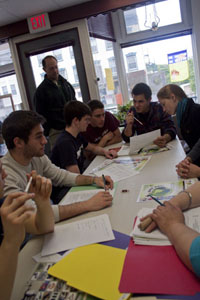Technology Clinic is collaborating with local community to create more welcoming public spaces
 Lafayette students feel a strong sense of community on campus, and now a Technology Clinic team of six students is trying to foster those same feelings in the surrounding Easton community. Working with the West Ward Neighborhood Partnership and supported by a grant from the Wachovia Regional Foundation, they are exploring ways to revitalize public spaces in an ecologically sound way.
Lafayette students feel a strong sense of community on campus, and now a Technology Clinic team of six students is trying to foster those same feelings in the surrounding Easton community. Working with the West Ward Neighborhood Partnership and supported by a grant from the Wachovia Regional Foundation, they are exploring ways to revitalize public spaces in an ecologically sound way.
Green renovation isn’t the only goal for the yearlong project; the team also wants to revitalize the West Ward in ways that potentially help the economy and build community identity. Already they have found locations such as large parks and the St. Anthony’s lot near St. Anthony’s Church and Easton Area Community Center. Next semester, they will develop a concrete revitalization plan to present to the West Ward community.
“We are looking for ways to get people interested and vested in gathering locations that are already available in the West Ward,” explains mathematics-economics major Hannah Klein ’11 (Wilmington, Del.). “There are several locations that are already gathering [places], but people typically do not go from one to another. By creating a space that looks better or safer, we can get people to move around and go to different locations.”
The team also includes economics and business major Justin Barry ’12 (Bridgewater, N.J.), government and law major James Maloney ’12 (Wallingford, Pa.), mathematics-economics major Alex Petroulias ’11 (East Quogue, N.Y.), international affairs major Kelley Reslewic ’12 (Highland Mills, N.Y.), and government and law major Christopher Vecchio ’11 (Cross River, N.Y.). Faculty advisers are Dan Bauer, professor of anthropology and sociology, and Larry Malinconico, associate professor of geology and environmental geosciences.
This is the third Lafayette project focusing on issues of urban ecology in the West Ward. One of the most beneficial aspects for the students has been touring the community and meeting with people who will be affected directly by the Tech Clinic recommendations.
“The West Ward Neighborhood Partnership is a great group that has taught me so much about what types of things bring a fairly urban environment together,” says Klein. “I never would have thought a small garden or a little park could unite a neighborhood, but now I see that it is the investment of a group in a project that gets a community to come together. Exploring and seeing what the situations are in the West Ward, we can make a bigger and better-informed impact. I have to say this experience has really helped shape my understanding of the West Ward and the real needs of the neighborhood.”
Success in molding plans for revitalizing a community takes input and expertise from students in a variety of disciplines.
“There are so many different majors involved in this project, and it has used all of our ideas,” says Klein. “We have people who look at this project in an economic way and others who look at it in a very political way, while I look at it from the point of view of someone interested in service and community-building. All the different majors and experiences have helped shape where this project is taking us.”
 Lafayette students feel a strong sense of community on campus, and now a Technology Clinic team of six students is trying to foster those same feelings in the surrounding Easton community. Working with the West Ward Neighborhood Partnership and supported by a grant from the Wachovia Regional Foundation, they are exploring ways to revitalize public spaces in an ecologically sound way.
Lafayette students feel a strong sense of community on campus, and now a Technology Clinic team of six students is trying to foster those same feelings in the surrounding Easton community. Working with the West Ward Neighborhood Partnership and supported by a grant from the Wachovia Regional Foundation, they are exploring ways to revitalize public spaces in an ecologically sound way.